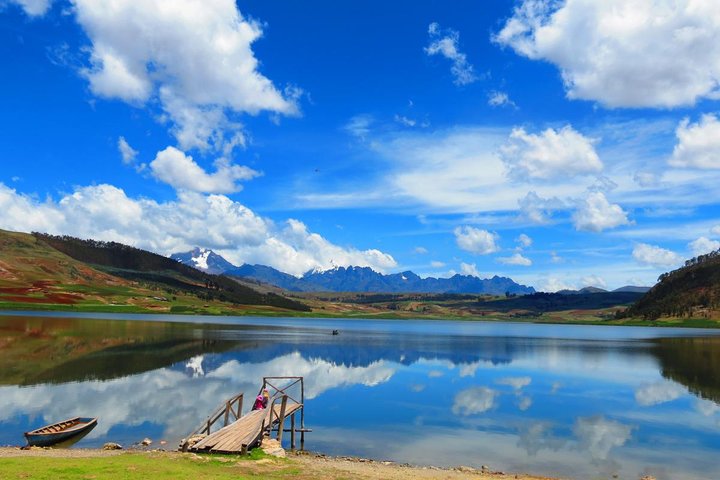Full Valley Day Tour: Pisac, Ollantaytambo|Maras|Moray |Chinchero
Share this tour

Offered languages
- Portuguese
- English
- Spanish
The Inca textile art is one of the oldest textile traditions of the Andes and it became one of the most developed during the Inca apogee, due to the use of different materials and techniques (result of its hybrid culture acquired thanks to the conquests of other Andean ethnic groups). The Incas managed to produce a wide variety of clothing and items for everyday use.
Huaypo is one of the most beautiful lagoons of the Sacred Valley, Beautiful lagoon with crystal clear waters, Huaypo welcomes a wide variety of fish and birds (Local Trout, king Fish, Parihuana or Flamingos, local ducks, Andean Caracara, Hummingbird, and some more) around the perimeter and extension of the lagoon within its approximately 1.5km by 800m in length, fully recommended for bird watching and a great Picnic area surrounded by the great fields of agriculture use by the Local Quechuas.
What's Included
Meeting and pickup
"What to bring: Weather-appropriate clothing and your passport (required). We recommend comfortable walking shoes and layers for changing mountain weather." You might also want to add: • "Sunscreen and hat recommended for high altitude" • "Small backpack for personal items" • "Camera for stunning photo opportunities"
Itinerary
-
1Chinchero
The Inca textile art is one of the oldest textile traditions of the Andes and it became one of the most developed during the Inca apogee, due to the use of different materials and techniques (result of its hybrid culture acquired thanks to the conquests of other Andean ethnic groups). The Incas managed to produce a wide variety of clothing and items for everyday use. Huaypo is one of the most beautiful lagoons of the Sacred Valley, Beautiful lagoon with crystal clear waters, Huaypo welcomes a wide variety of fish and birds (Local Trout, king Fish, Parihuana or Flamingos, local ducks, Andean Caracara, Hummingbird, and some more) around the perimeter and extension of the lagoon within its approximately 1.5km by 800m in length, fully recommended for bird watching and a great Picnic area surrounded by the great fields of agriculture use by the Local Quechuas.
1 hour • Admission ticket free -
2
The Inca textile art is one of the oldest textile traditions of the Andes and it became one of the most developed during the Inca apogee, due to the use of different materials and techniques (result of its hybrid culture acquired thanks to the conquests of other Andean ethnic groups). The Incas managed to produce a wide variety of clothing and items for everyday use. Huaypo is one of the most beautiful lagoons of the Sacred Valley, Beautiful lagoon with crystal clear waters, Huaypo welcomes a wide variety of fish and birds (Local Trout, king Fish, Parihuana or Flamingos, local ducks, Andean Caracara, Hummingbird, and some more) around the perimeter and extension of the lagoon within its approximately 1.5km by 800m in length, fully recommended for bird watching and a great Picnic area surrounded by the great fields of agriculture use by the Local Quechuas.
1 hour • Admission ticket included -
3Moray
The Sacred Valley of the Incas is home to the archaeological site of Moray, a place with agricultural terraces that, at first glance, look like amphitheaters. These concentric terraces were built by the Incas as an agricultural laboratory. Each of its terraces has its own microclimate, according to the depth at which it is located.
1 hour • Admission ticket included -
4Salinas de Maras
The salt mines themselves are made up of a set of approximately 4,500 salt pools located in the form of stepped terraces on the middle slope of the Qaqawiñay hill with slopes of 20 degrees incline to the bottom of the ravine on the left bank of the Salineras stream, with dimensions that fluctuate around 5 linear meters, occupying a total area of approximately 1.5 to 2 hectares
1 hour • Admission ticket included -
5Ollantaytambo
Historical Significance: Ollantaytambo was a strategic military, religious, and agricultural center during the Inca Empire. Built by Inca emperor Pachacuti in the 15th century as a royal estate. Later used by Manco Inca Yupanqui as a stronghold during his resistance against the Spanish conquest (notably the Battle of Ollantaytambo in 1537 — a rare Inca victory). Today, it's considered one of the best-preserved examples of Inca city planning.
1 hour • Admission ticket free -
6
Immerse yourself in Peruvian culture with this unique hands-on experience! Visit a local community where you'll learn the art of traditional bracelet-making directly from skilled local artisans.
1 hour • Admission ticket included -
Urubamba (Pass by)
In the Sacred Valley, between Cusco and Ollantaytambo Altitude: ~2,871 m (9,419 ft) above sea level Sits along the Urubamba River, at the base of snow-capped mountains like Chicón
Admission ticket free -
7Pisac
Agricultural Terraces (Andenes) Spectacularly engineered terraces built into the mountain for farming and erosion control. Still functional today — some are used by local farmers.
1 hour • Admission ticket free
Additional info
- Suitable for all physical fitness levels
- Children must be accompanied by an adult
- Passport name, number, expiry and country is required at time of booking for all participants
- Operates in all weather conditions, please dress appropriately
- Please advise any specific dietary requirements at time of booking
Tags
Cancellation Policy
For a full refund, cancel at least 24 hours before the scheduled departure time.
Show more
Cancellation Policy
- For a full refund, you must cancel at least 24 hours before the experience’s start time.
- If you cancel less than 24 hours before the experience’s start time, the amount you paid will not be refunded.
- Any changes made less than 24 hours before the experience’s start time will not be accepted.
Rating
You can cancel up to 24 hours in advance of the experience for a full refund.
Your guide to the flawless travel experience

















